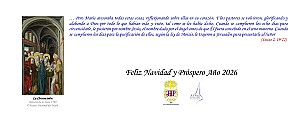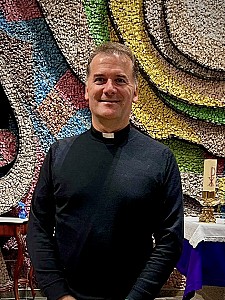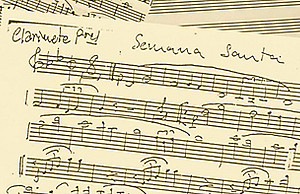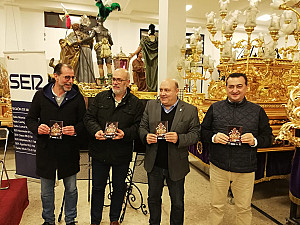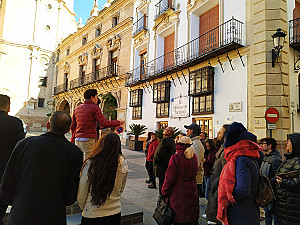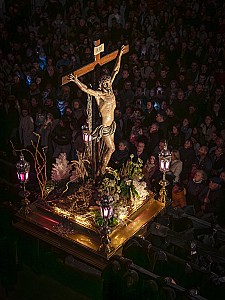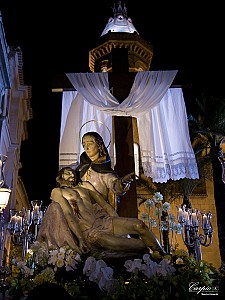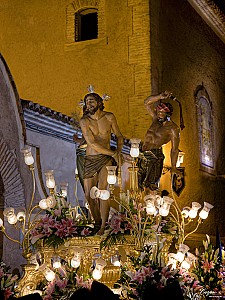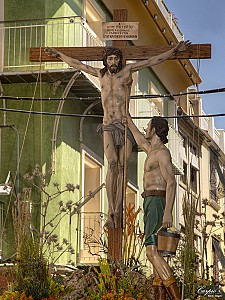| Vox populi |
| El Silencio o Los Azotes |
| Origen y constitución |
| Se constituye en 1931 |
| Los primeros Estatutos conservados datan de 1934 |
| Día, Procesión y Paso |
| Miércoles Santo en la Procesión General con La Flagelación |
| Jueves Santo en la Procesión del Silencio con el Santísimo Cristo de la Agonía |
| Viernes Santo en la Procesión del Penitente con Jesús en el Calvario |
| Viernes Santo en la Procesión del Santo Entierro con la Santísima Virgen de la Piedad |
"Al pasar la Imagen del Santo Cristo de la Agonía, postrados reverentemente de rodillas, pueden decir, sin que nadie les oiga: Adorámoste, Cristo y bendecímoste; pues por tu santa Cruz, redimiste al mundo". Con esa admonición concluía la última página del programa oficial de la Semana Santa de Cieza 1931, una última página que celebraba y daba la bienvenida a "un grupo de ciezanos creyentes y amantes de sus tradiciones que han solicitado la autorización necesaria para celebrar la Procesión del Silencio".
Nace esta Cofradía en 1931 (ya con anterioridad, en 1896 concretamente, hubo un intento de crearla según se desprende de dos noticias aparecidas ese mismo año en el periódico local 'La Voz de Cieza', la primera de ellas el 29 de marzo: "Para otro año ya se habla de una nueva hermandad del Cristo de la Agonía cuya preciosa imagen costeó de su bolsillo particular el respetable anciano Sr. D. Pascual Camacho y de que ya nos ocupamos, es sensible no luzca ya este año en las procesiones"; la segunda el 6 de abril: "Si mañana se hiciera una hermandad del Cristo de la Agonía, ésta con su imagen, debería ir la última antes de San Juan y la Virgen".), en una época en la que los Desfiles Procesionales de nuestra localidad se encuentran en franca decadencia, pues del panorama procesional han desaparecido los grandes apellidos que soportaban con su estipendio la grandeza, suntuosidad y magnificencia de tronos e imágenes.
Popularmente conocida como Hermandad del Silencio (e incluso, en sus comienzos, como Hermandad de los Negros), a ella se debe la creación de la Procesión de su mismo nombre, el Silencio (tal vez inspirada en su homónima de Granada instaurada dos siglos atrás), que sale a la calle en la última hora de la noche de Jueves Santo y que desde entonces, exceptuando algún año (1941) en que el Desfile estuvo acompañado del rezo del Vía Crucis, ha mantenido intactas sus señas de identidad.
Tal tuvo que ser el impacto de esta Procesión en las gentes de la época, que posteriormente el Doctor D. Ramón Sánchez Parra, ciezano de adopción, la implantó en 1943 en Murcia capital para la Cofradía del Santísimo Cristo del Refugio, de la que él mismo fue fundador y primer Presidente, y con la que la Cofradía ciezana se hermanó en 2005 con ocasión de su 75 aniversario.
Los primeros estatutos de la Cofradía -de la que fue su primer Presidente D. Mariano López Lucas (1930-1934) y en la que figuraban entre otros D. Antonio Ballesteros, D. José Maria Guirao, D. Antonio Ortiz, D. Isidoro Gil, D. Diego Jiménez Castellanos (creadores probablemente también en 1931 de la Asociación Amigos de las Procesiones, que pudo ser el germen de la propia Cofradía)- establecen como fin de la misma fomentar en cuanto puedan el culto al Santísimo Cristo de la Agonía; en virtud de ello y en sus inicios celebran anualmente un solemne novenario en el que, entre otros, predica en 1935, coincidiendo con la presidencia de D. Antonio Ortiz (1934-1936 y 1939), el futuro Obispo ciezano D. Diego Tortosa.
La Cofradía, pionera en dotar a sus Pasos de alumbrado eléctrico, desfila por primera vez por las calles de Cieza en 1931, con una Imagen que, bajo la advocación de Santísimo Cristo de la Agonía, realizara en 1895 para la Iglesia de Nuestra Señora de la Asunción, por encargo de D. Pascual Camacho y Cortes, el afamado escultor tarraconense Agustín Querol (algunas fuentes precisan que esta Imagen se encargó para sustituir a otra de la misma advocación realizada por Roque López en 1793 y que habría desaparecido), y lo hace sobre un trono de pequeñas dimensiones, de estilo sobrio y en madera barnizada, obra del artesano ciezano y cofrade fundador Bautista Molina, autor también del Retablo de la Imagen en su capilla de la Basílica de Nuestra Señora de la Asunción ("El 1 de Noviembre de 1895 llegó a Cieza la magnífica Imagen del Santísimo Cristo de la Agonia, costeada por don Pascual Camacho y Cortés y obra meritosísima del eminente escultor don Agustín Querol. Costó la imagen 2.500 pesetas y aún se venera en la Iglesia parroquial de Nuestra Señora de la Asunción, en la capilla de la Virgen de Lourdes. Es, sin duda, una de las esculturas que tiene Cieza de más mérito artístico". Ramón María Capdevila, Historia de Cieza).
La llegada de la Imagen del Santísimo Cristo de la Agonía a Cieza esconde una historia digna de relatar: "D. Pascual Camacho y Cortes era miembro de la masonería y fundador de la logia Cartella de Cieza. En el año 1988 sufrió lo que podíamos llamar una crisis de conciencia tras asistir a los oficios de Navidad; hasta tal punto creció su turbación que truncó cuarenta años de militancia en la masonería, convirtiéndose al cristianismo. Comenzó entonces a construir una capilla en su finca de la Fuente del Rey, capilla que no vio terminada, y fue a Roma ex profeso a implorar del Papa León XIII su perdón. A la vuelta de este viaje pasó por Madrid y encargó a Querol la mencionada Imagen, que luego depositaria en la Iglesia de Nuestra Señora de la Asunción la Asunción en una capilla que también costeó de su propio peculio".
No obstante, la atribución a Agustín Querol de la obra ofrece alguna duda, sobre todo por lo poco familiarizado que se encontraba el artista con la imaginería en general y con la talla en madera en particular. Dado que no se conserva ninguna fotografía de la obra perdida ni ninguna otra documentación sobre la autoría, se mantiene aún la incógnita de esta talla que ya muy pocos recuerdan con precisión.
En la Guerra civil la Imagen del Santísimo Cristo de la Agonía, al igual que otras muchas, fue quemada en la puerta de la Basílica (un particular pudo salvar de las llamas un fragmento de pie que hace unos años fue donado al Museo de la Semana Santa de Cieza); no sucedió lo mismo con el trono, que se conservó oculto en casa de la Camarera de la Cofradía, Dª Josefa Carrillo Camacho -sucedida a su muerte en el cargo por su hermana, Dª Visitación Carrillo Camacho, y ésta a su vez por su hija, Dª Encarna Alcázar Carrillo-, quien vendió una finca exclusivamente para comprar en Granada los faroles de plata del mismo.
A finales de 1939, un grupo de hermanos fundadores que habían sobrevivido a la contienda y entre los que se encontraban, D. Antonio Ortíz, D. José Villalba, D. Manuel Marín Buendía y D. José Maria Guirao, se reúnen en el desaparecido Bar Isidoro con el fin de reorganizar la Cofradía y encargar una nueva Imagen que sustituya a la destruida. Contactan con Juan González Moreno para que, en la medida de lo posible, realice una réplica de la anterior (el encargo del Cristo fue una apuesta personal del entonces Presidente D. Antonio Ortíz, bien relacionado con miembros de los círculos artísticos de la capital de la Región, quienes le recomendaron al joven escultor murciano). La nueva Imagen del Santísimo Cristo de la Agonía, que resultó, sin embargo, de concepción propia y de mayor tamaño, debido a que para su modelado posó el hermano del propio artista, José, hombre de gran envergadura física, y por la que el escultor murciano cobró 7.000 pesetas, se incorporó a las Procesiones en 1941, desfilando sobre un trono, de mayores dimensiones que el originario, realizado en madera por el escultor ciezano Manuel Juan Carrillo Marco, trono que a su vez fue revestido de metal en 1980 por el maestro orfebre ciezano Francisco Penalva, cuyos hijos, Francisco y Diego, lo restauraron respectivamente en 1997 y en 2008, y que se completa con un juego de galas bordadas en seda sobre terciopelo. La Imagen, por su parte, fue restaurada en 2005 por el restaurador ciezano Antonio García Egea.
En 1942 la Cofradía tiene noticia de que "la familia Guirao tiene el propósito de que uno de los mejores imagineros de España talle un grupo escultórico representando a la Virgen con Cristo muerto en sus brazos". La escultura, obra de José Capuz, será la Santísima Virgen de la Piedad, que desfilará por primera vez en la noche de Jueves Santo de 1943, sobre un trono construido en Cieza según boceto del propio escultor, acompañando al Santísimo Cristo de la Agonía en la Procesión del Silencio. La nueva configuración de esta Procesión, sin embargo, no tendrá continuidad, por el deseo de la Cofradía de desfilar en una noche tan especial sólo con la Imagen del Santísimo Cristo de la Agonía; así, el Paso de 'La Piedad' se ubicará definitivamente en la Procesión del Santo Entierro en la noche de Viernes Santo, y en la tarde de ese mismo día, desde entonces y hasta la década de los setenta, se realizará su Traslado desde el Convento de San Joaquín y San Pascual hasta la Basílica de Nuestra Señora de la Asunción, donde tiene retablo propio en la capilla del Titular de la Cofradía.
El Paso, que durante unos años contó con una Camarería propia e independiente, pasó a formar parte de la Cofradía bajo la Presidencia de D. José María Guirao Ortega (1940-1954 y desde 1954 hasta su fallecimiento Presidente de Honor). Esta ha llevado a cabo la restauración y plateado del trono en dos ocasiones: la primera en 1990, efectuada por el artista local José Morote Dato, Hermano de la Cofradía; y la segunda en 1997, por el tronista ciezano Bonifacio Pérez Ballesteros; a estas se suma el nuevo plateado de los brazos de luz que llevó a cabo en dos mil once el orfebre ciezano Diego Penalva. También abordó la Cofradía la restauración del grupo escultórico, que fue realizada en 2002 por Antonio García Egea, así como la confección de unas galas de terciopelo bordadas en plata por el Taller de bordado de la misma en 2007. Durante muchos años la cruz del Paso estuvo ornada con mantillas de novia donadas al mismo por fieles devotas; en la actualidad luce un sudario confeccionado por hermanas de la Cofradía.
En los años que siguen a la guerra civil la Cofradía inicia también gestiones con los herederos de la familia Marín Oliver para que estos le confíen su Paso de La Flagelación, conocido popularmente desde tiempo atrás como 'Los Azotes', con el compromiso de restaurar las Imágenes de los Sayones, que la familia había salvado de la quema de Santos durante la Guerra Civil, y de encargar otro Cristo de la Columna que sustituyera al desaparecido en la misma. Esta última escultura, surgida de las manos de Juan González Moreno en 1947 y restaurada por Antonio García Egea en 1990 desfila junto a las de los Sayones sobre un trono realizado en 1896 por el ciezano Antonio Gómez Cervantes con tallas del murciano Fulgencio Fernández ("El 14 de marzo de 1896 se construyó el anda para el grupo de los Azotes costeado por don Antonio Marín Oliver y construido por el maestro Antonio Gómez (el Coco), estando las tallas a cargo del joven y reputado artista murciano don Fulgencio Fernandez".), que fue restaurado y dorado nuevamente en el año 1997 por Bonifacio Pérez Ballesteros; la empresa valenciana de restauración Thader, bajo la tutela de la Dirección General de Bellas Artes de la Comunidad Autónoma de la Región de Murcia, restauró, por su parte, el grupo escultórico al completo para la Semana Santa de 2009, fecha en la que también se le sustituyeron a la Imagen del Señor de la Columna las ligaduras, muy deterioridas, por otras idénticas.
De las antiguas Imágenes que pudieron componer el Paso a lo largo de todo el siglo pasado, Díaz Cassou, en su libro Pasionaria murciana, afirma que cuando Salzillo talló el grupo de La Flagelación para la Cofradía de Jesús de Murcia, esta vendió, en 1793, su antigua Imagen de Jesús Atado a la Columna, de la que se desconoce la autoría, a la villa de Cieza por un valor de tres mil reales de vellón. Fuera así o no, lo cierto es que la Imagen de Jesús Atado a la Columna figura ya en la Procesión General a finales del siglo XVIII o principios del siguiente.
Hasta mediado el siglo XIX, cuando el Paso comenzara a desfilar también el la Procesión del Penitente en la mañana de Viernes Santo, las referencias alusivas al Paso mencionan sólo a la Imagen de Jesús Atado a la Columna, pero no a los Sayones (obra de Pedro Pérez en 1751), a los que el pueblo bautizaría como 'Los Judíos de Mateos' por guardarse el Paso en la Calle Larga en la cochera de D. Antonio Marín, 'Mateos', desde donde el Paso se incorporaba a la Traída de los Santos para su participación en la Procesión General, la única en la que participa hoy día.
Ya fuese la familia Marín la propietaria del Paso o simplemente la encargada de su arreglo para las procesiones, este estuvo vinculado desde sus orígenes hasta la guerra civil a la Cofradía de Jesús, que sufragaba los gastos derivados del mantenimiento del mismo y a la que pagan su tarja los anderos de La Flagelación. Así, en el Libro de Cuentas de la Cofradía de Jesús quedan reflejadas sucesivas restauraciones del Paso, como las efectuadas en 1856, año en que se le colocan a las Imágenes de los Sayones ojos de cristal y el escultor Santiago Arroyo restaura el Paso, o en 1869, cuando se reparan y pintan las andas; y en el que un apunte de 1853 podría incluso estar indicando la fecha y el autor de las mismas: "Al ebanista ¿Sangloni? por componer y pintar los judíos del Paso de la colugna, 200; Al mismo por montar, asegurar y pintar las andas de este paso, 70".
Sobre la conservación de los Sayones durante la cotienda civil dice la tradición oral popular que "fueron indultados en la quema de Santos porque alguien señaló que, precisamente por estar azotando al Señor, no merecían ser destruidas". Resulta irónico que merced a tan curiosa justificación estas magníficas tallas se hayan conservado hasta nuestros días.
El alumbrado eléctrico que se le introdujo al trono, tras su remodelación una vez acabada la Guerra Civil, dio al traste con sus peculiares bombas verdes, unas tulipas de cristal de un verde extraño a las que el llamear de las velas en su interior confería "un color inquietante y una tonalidad espectral que rodeaba a las dos siluetas de los judíos".
A partir de los años cincuenta la actividad de la Cofradía se encauza hacia su definitiva consolidación bajo las sucesivas Presidencias de D. Antonio Gómez Marín (1954-1959), D. José Villalba Martínez (1959-1973), D. Pablo Galindo Tormo (1973-1978) y D. Joaquín Jordán Pérez (1978-1988), quien iniciará una nueva etapa al frente de la Cofradía reformando sus Estatutos y solucionando así su artículo primero para dar cabida a las mujeres que como Hermanas desean pertenecer a la misma, lo que hasta entonces no había estado permitido, y acometiendo la restauración de la capilla del Titular, en cuya restauración y remodelación trabaja de nuevo hoy la Cofradía.
En el 2000, bajo la Presidencia de D. Manuel Verdejo Miñano (1988-2005) la Cofradía adquirió su cuarto Paso, Jesús en el Calvario, popularmente conocido como 'El Cristo de la Sed', un grupo escultórico formado por dos Imágenes (Cristo crucificado y un Sayón que le ofrece la esponja con vinagre) talladas en madera por el imaginero murciano José Antonio Hernández Navarro y que desfila sobre un trono dorado en madera del que es autor Bonifacio Pérez Ballesteros. El nuevo Paso se ubicó en la Procesión del Penitente de la mañana de Viernes Santo, sustituyendo así al Paso de La Flagelación, que ese mismo año se incorporó a su vez a la Procesión del Prendimiento de la noche de Martes Santo, Procesión en la que participó hasta 2008.
Desde 2017 la Cofradía suma un estandarte diseñado y bordado por el Taller de Felicitación Gaviero. Confeccionado sobre terciopelo negro, de marcado carácter baroco, con la inclusión en el centro de una pintura de la imagen de su titular, realizada por el afamado Raúl Berzosa. Por otra parte en 2006 los antiguos báculos que el Maestro Penalva realizara para el Tercio de nazarenos (penitentes) de la Cofradía hacia 1970 serán sustituidos por otros realizados por su hijo Diego según diseño del Cofrade Francisco José Martínez Perpiñán.
La Cofradía recuperó para sus anderos en 1993 el tradicional gorro de 'moco' ciezano y cambió en 1995 sus cíngulos de lana por otros de seda; y bajo el mandato de D. Antonio Lucas Parra, renovó el vestuario de andero instaurando el gorrro de 'verduguillo'. Por lo que a los nazarenos se refiere, la Cofradía incorporó en sus inicios, y en detrimento del vestuario tradicional de la Semana Santa ciezana, un nuevo modelo de vestuario de corte marcadamente sevillano que todavía hoy conserva: túnicas negras sin cola y airosas capas blancas con capuz puntiagudo también negro.
Fotografías de Manuel Carpio y Enrique Centeno.
© Junta de Hermandades Pasionarias de Cieza
